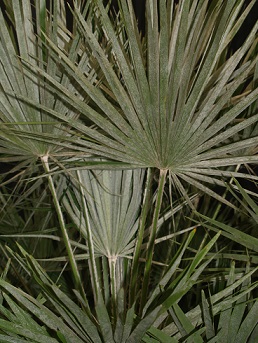Growing Palms as Indoor Plants
 Palms can be very successful as indoor plants; but not all species. Some don't tolerate lower humidity, higher levels of Carbon Dioxide or lower levels of sunlight that often occur inside. Others are more sensitive to fluctuations in soil moisture, or attack by pests, and without constant care and attention, may be more difficult to grow well as an indoor plant
Palms can be very successful as indoor plants; but not all species. Some don't tolerate lower humidity, higher levels of Carbon Dioxide or lower levels of sunlight that often occur inside. Others are more sensitive to fluctuations in soil moisture, or attack by pests, and without constant care and attention, may be more difficult to grow well as an indoor plant
The following palms however, are suitable to try indoors.
- Chamaedorea elegans (Palour Palm)
- Chamaerops humilis (European Fan Palm)
- Howea fosteriana (Kentia Palm)
- Lytocaryum weddellianum (Wedding Palm)
- Phoenix canariensis (Canary Island Date Palm)
- Phoenix reclinata (Senegal Date Palm)
- Phoenix roebelenii (Dwarf Date Palm)
- Rhapis excelsa (Lady Palm)
- Rhapis multifada (Jade Empress)
- Trachycarpus fortune (Chusan Palm, Windmill Palm or Chinese Windmill Palm)
Another palm grown indoors is Syagrus romanzoffianum (Cocos palm). This is commonly grown throughout Australia as an indoor plant because it is cheap to buy, not because it is particularly suited to growing indoors. However As long as it is given a spell outside in a shade house every 4-6 months it will last for many years.
Caryota plumosa, Dictyosperma, Licuala and Reinhardtia are also suitable as indoor plants but only in warm, humid climates
Mediterranean Fan Palm
There is only one species, the popular Chamaerops humilis, which is a particularly hardy palm thriving in sun or part shade and in most soil types. It is the only palm native to Europe. It will grow in altitudes of 1000m, tolerates moderate snow falls, with stands coastal conditions, full sun, shade and dry periods once established. Its form varies from a single trunk growing to 6m to clumps of ground-covering trunks (usually seen as low spreading plant). The fan leaves are narrow, stiff and dark green up to 1m in length. It can also be grown as a pot plant and is very suitable for indoor growing. Propagate from seed which germinates in 3-4 months. There are several different varieties which are sometimes incorrectly listed as different species.
Kentia or Sentry Palms (Howea)
There are only two species both from Australia (Lord Howe Island). With slender trunks, they are highly ornamental and excellent as indoor plants or as a landscape specimen. Both prefer coastal conditions and will not tolerate drought. They can take light frosts. Partial shade is necessary when young. Fresh seeds germinate within 2 to 12 months.
H. belmoreana (Curly Palm or Belmore Sentry Palm). To 6m high; fronds up to 3m or more long with distinctive upward arch to apex.
H. forsteriana (Kentia Palm). To 15m tall; fronds 3 to 4m long, at first erect then become slightly drooping. Very popular indoors worldwide.
You may also be interested in....